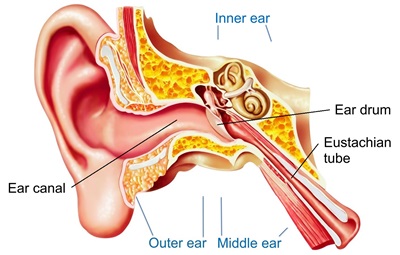Middle-Ear Infections
A middle-ear infection occurs when a bacterial or viral infection affects the middle ear — the air-filled space behind the eardrum that contains the tiny vibrating bones of the ear. Ear infections can cause pain due to the inflammation and fluid build up in the middle ear.
As acute ear infections can often clear up on their own, treatment can begin with managing pain and monitoring the infection. In some cases, doctors may need to prescribe antibiotics to clear the infection.
However, ear infections can also be chronic, with chronic ear infections either not clearing up or recurring many times. This can potentially cause damage to the middle and inner ear.
Children are more susceptible to ear infections than adults.

Symptoms
Common signs and symptoms of middle-ear infections in adults:
- Earache – pain in the ear that is sharp, dull, or throbbing
- Drainage of fluid from the ear
- Difficulty hearing, muffled hearing
Signs and symptoms of middle-ear infections in Children:
- Pain in the ear, especially when lying down
- Tugging or pulling at an ear
- Trouble sleeping
- Crying more than usual
- Fussiness
- Trouble hearing or responding to sounds
- Loss of balance
- Fever of 38 C or higher
- Drainage of fluid from the ear
- Headache
- Loss of appetite
What causes an ear infection?
An ear infection is caused by a bacterium or virus in the middle ear, often beginning as another illness, such as cold, flu or allergies, that causes congestion and swelling of the nasal passages, throat and eustachian tubes.
The eustachian tubes are a pair of narrow tubes that run from each middle ear to high in the back of the throat, behind the nasal passages. The throat end of the tubes open and close to:
- Regulate air pressure in the middle ear
- Refresh air in the ear
- Drain normal secretions from the middle ear
When the eustachian tubes are swollen, they can become blocked, and cause fluid to build up in the middle ear. The built-up fluid can become infected and cause the symptoms of an ear infection.
The reason why children are more prone to ear infection, is because their eustachian tubes are narrower and more horizontal. This makes them more likely to get clogged as they are difficult to drain.

Diagnosing an ear infection
Your doctor will examine your ears with an instrument called an otoscope, to check your middle ear and eardrum for swelling, redness, fluid or even air bubbles. If the infection is advanced, a sample of the fluid may be taken and tested, to determine how the doctor can prescribe medication to help you recover.
Sometimes, a CT scan may be called for, to determine if the infection has spread beyond the middle ear. You may also need a hearing test, especially if your ear infections are chronic.
How are ear infections treated?
Most ear infections can clear up without intervention. However, ear infection in infants and severe cases are likely to require treatment with antibiotic medication.
The following methods can be useful in relieving the symptoms of a mild ear infection.
- Applying a warm cloth/heat pack to the affected ear
- Over the Counter pain medication
- Over the Counter or prescription ear drops
- Gently washing the outer ear with soap and a face cloth to remove any discharge
If your symptoms do not improve or continue to worsen, make an appointment to consult your doctor. They may need to prescribe antibiotics to fight the infection.
Ear infection in Children
Ear infections are most common in children below 3 years old. Children with weak immune systems are also more likely to get ear infections than healthy children. Family history also plays a part; a child is more likely to have recurrent middle-ear infections if a parent or sibling has also suffered from them. Other risk factors include recurrent colds and upper respiratory infections, and exposure to cigarette smoke. Being in a childcare centre with other children also increases the risk as viruses can spread quickly among children, causing colds that could lead to ear infections.For more information on Ear Infections in Children, read our post here.








